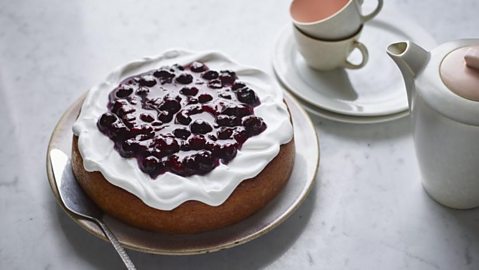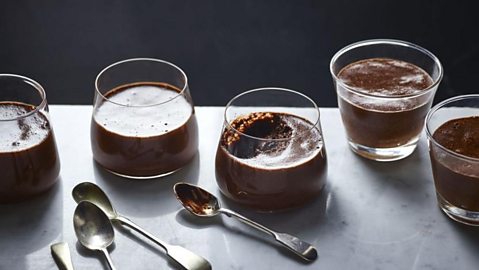How can I make pancakes without eggs, gluten or dairy?
A basic pancake is one of the simplest recipes to make. Three store cupboard ingredients come together to form a batter that is cooked in a shallow pan to create thin, lacy pancakes.
But what happens when you start to substitute ingredients to make them dairy free, egg free or gluten free?
Can you remove gluten from the equation?
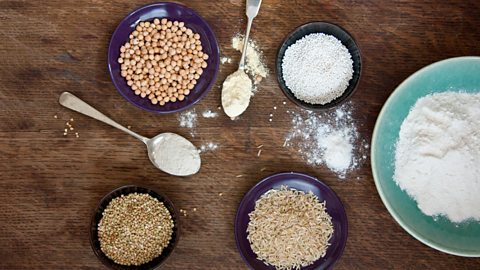
Gram flour
Made from chickpeas, gram flour is often used in Indian cooking. It has a strong, slightly sour, earthy flavour, which means that it is best used to make savoury pancakes. Chickpea flour is very absorbent, resulting in a light, crisp pancake, best eaten straight away.
Tapioca flour
Tapioca flour is made from dried cassava (a tropical plant) starch. It can become stringy when mixed with water, and is usually mixed with other gluten-free flours, such as rice flour when used in baking. Its neutral flavour lends itself well to pancakes.
Buckwheat flour
Buckwheat flour is made from buckwheat groats and while it doesn’t contain gluten, it does contain a small amount of mucilage (a thick, viscous substance such as the gloop you get when porridge oats are mixed with water), which helps the batter bind together. The lack of gluten makes buckwheat pancakes very tender, but many recipes also add a little gluten-containing flour or another agent such as xanthan gum for elasticity. Buckwheat flour gives pancakes a nutty flavour that works well with savoury fillings.
Rice flour
Rice flour is often the main component of gluten-free flour mixes. It is usually made from brown rice, and has a low moisture content, which can cause a dry, crumbly result. It is often mixed with starchier flours such as tapioca, and supplemented with an emulsifier such as xanthan gum for elasticity. Like tapioca flour, rice flour has a neutral flavour.
Can you make pancakes without eggs?
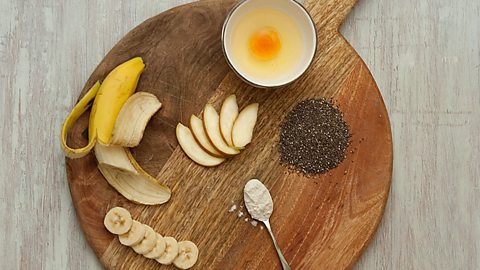
The proteins in eggs help pancakes to set as they coagulate over heat, but there are plenty of natural alternatives, including:
Ground chia or flax seeds
Both chia and flax seeds are particularly mucilaginous, thanks to a gum in their coating. As a rough guide, mix one tablespoon of seed powder with three tablespoons of water, and leave for five minutes to thicken up into a gel that will mimic the binding effect of one egg.
Pureed fruit and vegetables
Pureed fruit and vegetables can also be used to bind a pancake batter together. Try adding half an overripe banana mashed, two tablespoons of apple sauce or the same of mashed butternut squash for each egg in the recipe. Be careful to choose a fruit or vegetable that suits the pancakes you're making.
Baking powder
If leavening is what you are after, which would be the case with American-style pancakes, you can use baking powder in place of an egg. For fluffy pancakes, add one teaspoon of baking powder for each egg in the recipe. You could also try adding a little cider vinegar to the mix for an even lighter result. If you are avoiding gluten do make sure that you use a gluten-free baking powder.
Cornflour or tapioca starch
Both cornflour and tapioca starch are traditionally used to thicken sauces and gravies. Try mixing one tablespoon of starch with three tablespoons of water and add to your pancake batter to help it bind together.
Do you need to follow the herd?
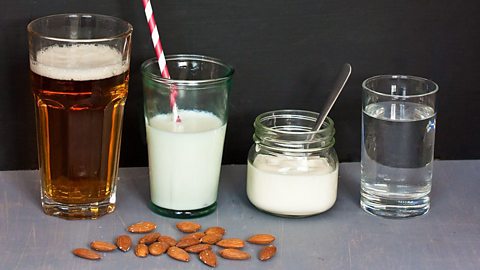
Dairy milk isn’t going to make or break your pancakes, but it does add flavour and the sugars it contains can encourage those lovely brown spots you’re looking for. Other liquids you could try are:
Water
Many pancake recipes call for a combination of milk and water. This is because milk adds flavour while water encourages a light, lacy pancake. Savoury pancakes tend to just use water, usually because the flour used, such as gram or buckwheat, has a strong flavour itself. If using water in a sweet pancake you could add another flavour, such as cinnamon or vanilla.
Beer
Pancakes can be made with beer, which adds both flavour and lightness to a batter. However, beer can result in a slightly yeasty flavour and is probably best saved for savoury pancakes. Beer and buckwheat flour is a common combination often seen in France.
Soy, oat or nut milk
Dairy-free milks such as soy and almond milk can be used easily. Some recipes add a bit of sugar when using soy milk, while almond milk has a distinctive almond flavour. Other dairy-free milks to try include oat milk, coconut milk and rice milk.
Buttermilk or yoghurt
You can swap milk for soured buttermilk or yoghurt for an extra soft pancake. This is because its thick consistency means that you can add less flour, which reduces the amount of gluten and starch, allowing for a more delicate result.
Pancakes by numbers
The ratio below will help you to make perfect pancakes every time. You may need to alter it slightly depending on the ingredients used.
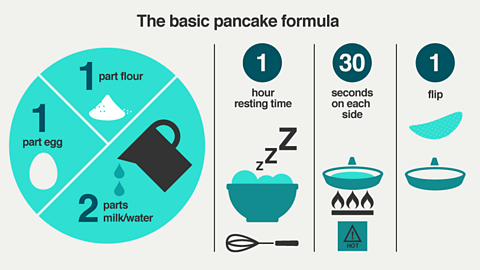
Originally published March 2019
Want more? Visit BBC Food on Instagram, Facebook and Pinterest. Want to watch the latest Food TV programmes? Visit BBC iPlayer.

